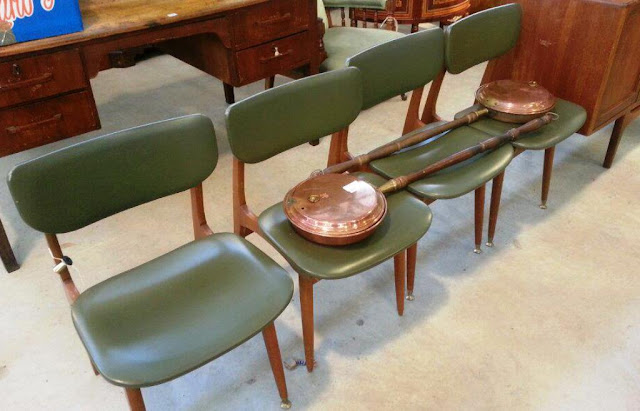In the last couple of weeks I have shared some of the early processes in buying at auction. You can read about viewing days here and registering to bid here. But it's time to get to the most important fun part of the auction process, bidding for an auction lot, and hopefully winning.
 |
| Tullochs Auctions |
Most general auctions may be made up of a combination of items that either have a reserve price, or don't have a reserve price. A reserve price is a price set by the seller that they do not want the item sold under. If the item fails to reach the reserve price at auction then the item is 'passed in' or in other words isn't sold and may be offered again at a forthcoming auction...more about this after!
 |
| Tullochs Auctions |
Often items that have no reserve price may be lots that come from a deceased estate where the family may just want the items sold or where the expected value or interest in a lot may not be considered high enough to warrant a reserve price attached.
 |
| Armitage Auctions |
You need to pay close attention to the auctioneer who will explain the terms and conditions of the auction. Read more about buyer's premiums here. Auctioneers will also generally speak quite fast and so you need to be listening for your lot number to be called. Fortunately the numbers are usually called sequentially so that makes it easier. The exception to this may be if a particularly desirable item has been advertised to auction at a certain time. The auctioneer might interrupt the sale to conduct the bidding on that item and then return to the regular lots.
 |
| Armitage Auctions Auctions can be crowded and may or may not have seating. Put yourself in a position where the auctioneer can have eye contact with you, and be prepared to raise your hand or call out to bid, especially in the first instance. Once the auctioneer sees your interest they will keeping looking back to you for bids. Generally the auctioneer will start the bidding at a price that is hoped to be achieved. If no one makes a bid they will drop the price until someone starts to bid. Bids will then go up in increments until the highest price over the reserve price is achieved. If no-one bids at all the lot will be 'passed in'. Bidding increments can range from $5 to $10 or to $50 or even $100 depending on the value of the item and the interest shown. Increments can also be changed midway through the bidding if the lot is showing a surprising amount of interest from bidders. |
 |
| Armitage Auction Rule of thumb is that you generally wouldn't offer a bid at the auctioneer's opening price, but will let the price drop. This is probably the standard procedure but there are times when it can work in your favour. Sometimes putting in a bid at the opening offer can silence other competitive bidders, they may assume you really want the item and are prepared to pay top dollar, and it signals to everyone immediately your interest in the item. This move is not without its risks though, and you need to be fairly sure of the items value and what you are prepared to pay. |
 |
| Armitage Auctions |
 |
| Tullochs Auctions Remember you will be bidding against other interested buyers who are present and 'book' or 'absentee bids' buyers, these are the people who couldn't attend the auction in person and for whom the auctioneer is bidding on behalf of. You can read about this process here. |
 |
| Tullochs Auctions |
If auctions are new to you then you will see many confident bidders or bidders to whom the auctioneers seem to turn to, to see if they are interested. These bidders would be regulars at the auctions and are probably buying for their own businesses, be it antique, second-hand stores or market stalls. There is no need to feel intimidated by their confidence, the auctioneer is just as happy to accept your money if you show the interest. In fact you can learn something important from these buyers and that is, that there will always be something similar down the track so don't bid beyond what you can afford to pay.
 |
| Armitage Auctions |
So take a deep breath, raise your hand, speak up, nod your head all in direct line of the auctioneer...whatever it takes to get noticed, and keep bidding...until either it goes beyond your price and you gracefully drop out, or until you're the winning bidder... yay! It's then just a matter of raising your buyer's number (don't forget that!) for the auctioneer to record.
 |
| Armitage Auctions |
The final step is paying for your item at the office, which can often be done before the auction finishes, just give them a little time to process your lot number. Then collect the item. If it's small you can often take it with you before the auction ends. If it's very large you may need to wait.
I said I'd mention lots that are 'passed in'. You can go to the office after a lot has been 'passed in' and usually make an offer on it. The auctioneer will get back to you if your offer has been accepted.
 |
| Armitage Auctions |
So there it is...the mystery of auctions. I hope you can get to enjoy an auction in the near future and that these tips will be helpful. Lisa xx

No comments:
Post a Comment